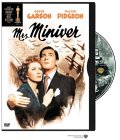Synopsis
Our story begins in 1939, just before the outbreak of WWII. The Minivers (Greer Garsonand Walter Pidgeon) enjoy an idyllic existence in a charming town where the biggest controversyis over whether the station master Henry Travers should be entering his rose against localaristocrat Dame May Witty’s in the flower competition. But then the war comes, and little bylittle, it reaches into the lives of the townspeople, wreaking ever more havoc. Through it all,Garson remains a tow…r of strength.
Yes, Canadian Walter Pidgeon is a hard sell as an Englishman. Yes, the studio-built town ismuch more New England than Olde. And yes, this is a propaganda film. But propaganda can stillbe great art (as the terrifying example of Triumph of the Will proves), and such is thecase with Mrs. Miniver, which was a greatly needed morale-booster in 1942. Even asone’s lip might curl at the utopian reconciliation of the classes (as symbolized by the flowercompetition), one’s lip also trembles as the family huddles together for comfort in the bombshelter. The film’s opening is so leisurely and sunny that one almost forgets this is a war film,until a fist of tension slowly but surely wraps itself around the viewer. A classic of its kind.
Audio
The mono soundtrack hasn’t been remastered into stereo. Good. But a bit of remastering atthe mono level wouldn’t have been amiss. While there is no hiss, the volume, especially of thedialogue, is too low, making some of the lines hard to hear. There is also one moment of gurgle.Otherwise the sound is clean and unobjectionable.
Video
For the most part, this is a good, clean print. There is some minor speckling here and there,but its appearances are very limited. About an hour in, there is more visible print damage inthe form of a vertical line. There is a bit of grain, but not much, and no edge enhancement tospeak of. The image is sharp, and when the picture is good (which is most of the time), it is verygood, with excellent shadings of black and white. The aspect ratio is, of course, the original1.33:1.
Special Features
The more substantial extras here are two 20-minute propaganda shorts, these ones aimedvery specifically at American audiences. “Mr. Blabbermouth” counters rumours of Japanesemilitary superiority with all sorts of facts and figures, while “For the Common Defense” is a minicrime thriller where the police of the US, Chile and Ecuador team up to thwart an Axis plot.Fascinating historical documents both. There is also footage of Greer Garson’s Oscar acceptancespeech, the theatrical trailer, and a still gallery. Some interesting features, then, but very littleabout the movie itself. The menu’s main screen is scored.
Closing Thoughts
There are many reasons why the film shouldn’t work, but it does, and it does very wellindeed. Credit the performances, and an utterly assured pushing of the audience’s buttons.
Special Features List
- “Mr. Blabbermouth” Short
- “For the Common Defense” Short
- Greer Garson Oscar Footage
- Theatrical Trailer
- Still Gallery





